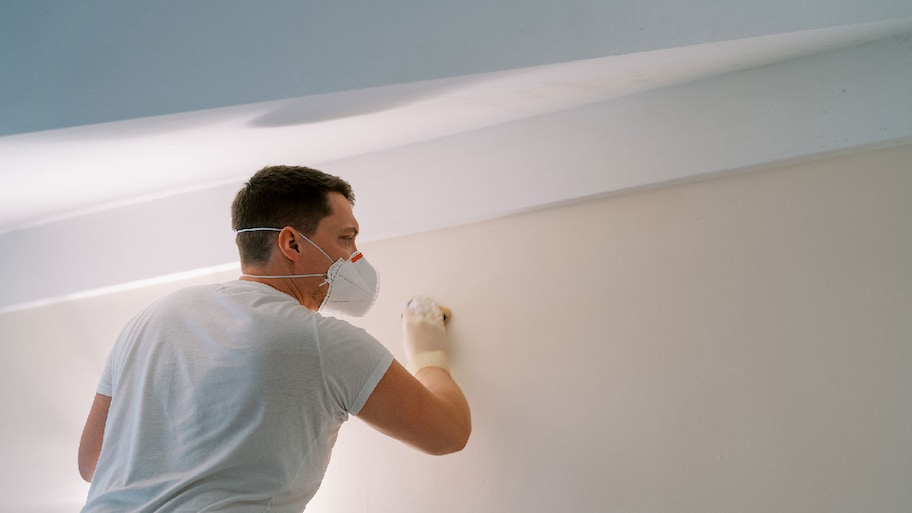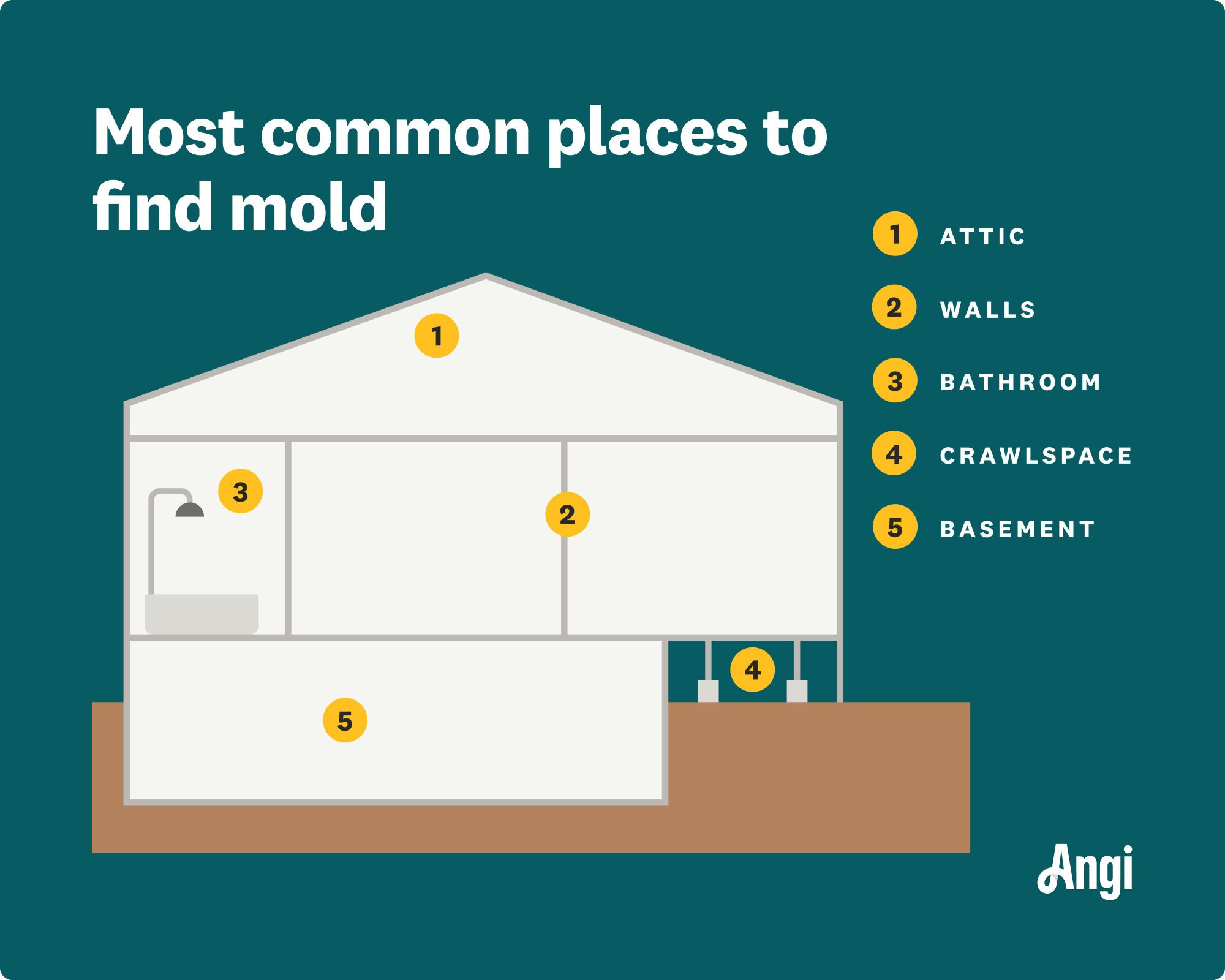How Much Does Mold Remediation Cost? [2024 Data]
Normal range: $1,223 - $3,749
Mold remediation costs $2,362 on average, but it can cost between $373 and $7,000, depending on location, type, and size of infestation.


Mold remediation costs an average of $2,362 and typically ranges from $1,223 to $3,749. One of the reasons mold remediation can be expensive is because there are significant health considerations that need to be addressed whenever mold is present. While people can remove small amounts of mold themselves—if you’re 100% sure it isn’t toxic—the best course for almost every discovery is to call a professional and have them remove it.
- Average
- $2,362
- Low end
- $373
- high end
- $7,000
How Much Does Mold Remediation Cost by Location in the Home?
| Location | Average Remediation Cost |
|---|---|
| Attic | $1,000–$4,000 |
| Basement | $500–$3,000 |
| Crawl space | $500–$2,000 |
| Wall | $1,000–$20,000 |
| HVAC systems | $3,000–$10,000 |
| Bathroom | $500–$1,000 |
| Whole house | $10,000–$30,000 |
It costs more to remove mold from certain areas of your home than others. For instance, mold growth in hard-to-reach areas, like in your HVAC system or drywall, can require more time and materials to remove than mold in very accessible areas, driving up costs.
Attic Mold Remediation Costs
Roof leaks can lead to attic mold since mold thrives in moist environments. It typically costs $1,000 to $4,000 to remove attic mold, depending on how easy it is to access your attic. However, if the roof leak is very large or has gone undetected for a considerable time, mold remediation can cost as much as $7,000.
In addition to removing mold, you should repair the roof leak to prevent further mold growth. Roof repair costs generally range from $350 to $1,250.
Basement Mold Remediation Costs
Basements are another area that tends to experience moisture and mold growth. It usually costs around $500 to $3,000 to remove basement mold, but costs can be higher if the mold is behind wood paneling or finished walls.
Basement mold growth often occurs due to foundation sealant problems, so addressing these can help prevent mold from infesting your home. The cost to seal the foundation ranges from $2,250 to $7,100.
Crawl Space Mold Remediation Costs
Crawl spaces are often damp and dark, making them prime targets for mold. However, they're also typically small, so mold remediation costs are often lower than in other areas, ranging from $500 to $2,000. Encapsulating your crawl space can help prevent future growth. Crawl space encapsulation costs range from $1,500 to $15,000.
Wall Mold Remediation Costs
Removing mold from your walls can cost anywhere from $1,000 to $20,000, depending on whether you need to remove mold from the surface or must replace the wall and everything behind it due to mold damage.
Mold that grows on drywall for a long time can destroy the drywall. Repairing drywall typically costs $300 to $825. Mold on wooden walls or concrete is more expensive to remove. Removing mold from wooden walls costs between $700 and $5,000, while concrete mold removal can range from $1,000 to $10,000 or more.
HVAC Mold Remediation Costs
HVAC systems require special cleaning to remove all airborne spores. The cost to remove mold from an HVAC system ranges from $3,000 to $10,000, depending on the type of system. For instance, it typically costs $1,500 to $5,000 to remove mold from a radiant heat system and $3,000 to $5,000 for furnace and air handler mold remediation. Removing mold from air conditioners usually costs around $6,000 to $10,000.
Like HVAC systems, air ducts often require special cleaning to ensure all airborne spores are removed. It typically costs $600 to $2,000 to remove mold from air ducts. You can schedule regular air duct cleanings to help prevent mold growth, which usually costs between $275 and $500.
Bathroom Mold Remediation Costs
The moisture inherent in most bathrooms often attracts mold. Costs to remove it generally range from $500 to $1,000, but if there's mold behind your sink, tub, or walls, costs can reach $8,000 or more.
Whole-House Mold Remediation Costs
Sometimes, toxic spores impact an entire house. This removal typically costs between $10,000 to $30,000, including removal and water damage repairs to prevent future issues. However, replacing upholstery, carpets, drywall, and more can add thousands to the final cost.
Mold Remediation Cost Factors

Don’t forget to consider these mold removal cost factors when creating your project budget.
Mold Infestation Size
Most mold removal professionals charge around $10 to $25 per square foot. So, if you're removing mold from a 100-square-foot area, you can expect to pay around $1,000 to $2,500. But factors like where the growth is and the mold type can affect how much it costs to remove it.
Mold Inspections and Tests
Mold testing typically costs between $250 to $350. Mold testing is key to determining whether you have the presence of mold in your home, plus the extent of the infestation. You’ll need to hire a mold inspector to test surface samples in your home before moving forward with remediation.
Mold Type
While mold testing typically costs $450 to $800 regardless of the mold type, it’s relevant to know which type you have in your home. For example, if a mold test reveals the presence of black mold, your mold remediation pro will likely charge more to remove it based on the additional cost of protective equipment.
Here are the common types of mold that require remediation:
Alternaria: Usually found outside in spring and summer, and attack primarily plants. Usually included in basic inspection and is rather common.
Aspergillus: White fuzz that turns black over time but can also be brown, yellow, and green. Can cause respiratory illness and requires immediate remediation.
Aureobasidium: Typically grows on painted surfaces and behind wallpaper. It’s often pink and causes allergies. Usually included in a basic inspection.
Chaetomium: Extremely toxic and can cause brain infections and various cancers. A white fuzz that turns to blue or green. Requires immediate professional removal.
Cladosporium: Usually included in basic inspection and is commonly found in basements and HVAC systems. It can cause mild allergy symptoms.
Fusarium: One of the most toxic and requires professional removal once discovered. Usually caused by water leaks, it is commonly found in walls and floors.
Penicillium: Blue-green and usually grows in areas of elevated moisture such as where water damage has occurred. Can be very dangerous.
Serpula lacrymans: Causes severe damage to wood and spreads fast. Unfortunately, this mold is usually found when it has already spread a good amount.
Stachybotrys chartarum (black mold): Classic and extremely dangerous, not to mention fast-spreading. Requires immediate removal by a professional.
Trichoderma: Grows rapidly in wood, plants, and soil. Commonly found in HVAC systems and not as widely discovered as some of the others in this list.
Ulocladium: A dark-colored mold usually found near windows and in kitchens and basements. Looks like black mold, but isn’t as toxic to humans. Nevertheless, it still requires removal.
Damage Caused by Mold
If mold is left untreated for too long, it can damage your drywall, carpeting, and flooring. Replacing or repairing your walls or floors will add costs to the removal.
| Type of Installation | Cost Range |
|---|---|
| Drywall | $1,000–$2,900 |
| Carpet | $775–$2,600 |
| Flooring repair | $200–$550 |
Mold Prevention
The three rules for preventing mold growth are moisture control, moisture control, moisture control. Mold cannot survive without humidity levels high enough to encourage growth. This is why you seldom see mold growing on the floor, and almost always find it inside walls, in cabinets, and in other areas where moisture sits or pools.
There are a few things you can do to combat moisture rising above 50% humidity, which is when mold really takes off. One of the best things you can do is install a powerful dehumidifier in high-humidity areas like basements. Always run the bathroom fan when bathing, and open kitchen windows when boiling water. A whole-home dehumidifier is probably the most effective preventative measure you can take.
Signs of a Mold Infestation

If you suspect you have a mold problem, you should always call a mold inspection professional to determine the location and extent of the mold. They can recommend the best next steps.
Signs that indicate a mold problem include:
Musty, earthy odor coming from a specific area
Warping, cracking, and peeling on the floors or walls
Leaks or water damage, especially in dark, warm spaces
Darkening around tile grout
Discoloration on the walls
Worsening allergy symptoms
Dry, itchy skin
DIY Mold Removal vs. Hiring a Remediation Professional
The Environmental Protection Agency (EPA) recommends only removing mold yourself if it covers less than 10 square feet. Otherwise, it's best to call a local mold removal service. That said, even if the mold looks like it only covers a small area, you should always call a pro to inspect it to ensure there isn't additional mold hiding behind walls or floors and to determine how harmful it is. Mold inspections typically cost $300 to $1,025. After the inspection, the pro can advise whether you need professional mold remediation services.
The cost to remove mold yourself typically ranges from $50 to $300. For small projects, the only piece of equipment you should need is a wet vacuum to pull moisture away from the area, which you can rent for around $30 per day or buy for $80 to $200.
To properly clean the area, you can purchase a pre-formulated mold remediation solution at the hardware store for around $10 to $75. However, very small mold removal projects usually only require water and detergent. Regardless of the solution you use, you should wear goggles, gloves, and an N95 respirator to protect yourself from the mold during the removal, all of which you can purchase for around $30 to $150 total. Use extreme caution and do your research before starting.
How Angi Gets Its Cost Data
Home is the most important place on earth, which is why Angi has helped more than 150 million homeowners transform their houses into homes they adore. To help homeowners with their next project, Angi provides readers with the most accurate cost data and upholds strict editorial standards. We’ve surveyed thousands of real Angi customers about their project costs to develop the pricing data you see, so you can make the best decisions for you and your home. We pair this data with research from reputable sources, including the U.S. Bureau of Labor Statistics, academic journals, market studies, and interviews with industry experts—all to ensure our prices reflect real-world projects.
Want to help us improve our cost data? Send us a recent project quote to [email protected]. Quotes and personal information will not be shared publicly.
Frequently Asked Questions
Mold is a fungus that typically grows in warm, moist environments, which is why it's so often found in bathrooms, attics, and under sinks. It survives by digesting decaying organic materials, which makes it very helpful for removing dead plant matter around the world. However, if it starts eating away at your drywall, window frames, and flooring, it can harm your home and your health.
Mold can grow anywhere with high moisture levels and potential "food" sources, like drywall, flooring, and window frames. Roof leaks, flooding, plumbing leaks (a common problem new homeowners face), and high humidity are all moisture sources that can lead to mold growth, which is why it's important to address leaks and other water damage as soon as you can.
Mold remediation costs $1,125 to $3,345 to remove mold with a national average cost of $2,225. The reason the cost is high is because there are various health risks associated with toxic mold, such as respiratory distress and carcinogens, with some molds even causing damage to your nervous system. Remediation is not only about removing the mold, but fixing issues that could contribute to future growth. The last thing anyone wants is a toxic mold returning.
The answer depends on the size of your home, the type of mold, and your ventilation systems. However, the best answer would be no, you shouldn’t stay in your home. Arrange to be away from your home during the mold remediation process, as mold is often most dangerous when it’s being removed due to the particles being released into the air. Some contractors won’t proceed with the remediation if you or other household members are in the home.
According to the EPA, mold allergies are common and can cause skin irritation, respiratory problems, headaches, and other allergic reactions. Mold allergies can also trigger asthma attacks in people with asthma. Additionally, some molds produce mycotoxins, which can lead to very serious conditions, like lung cancer.
